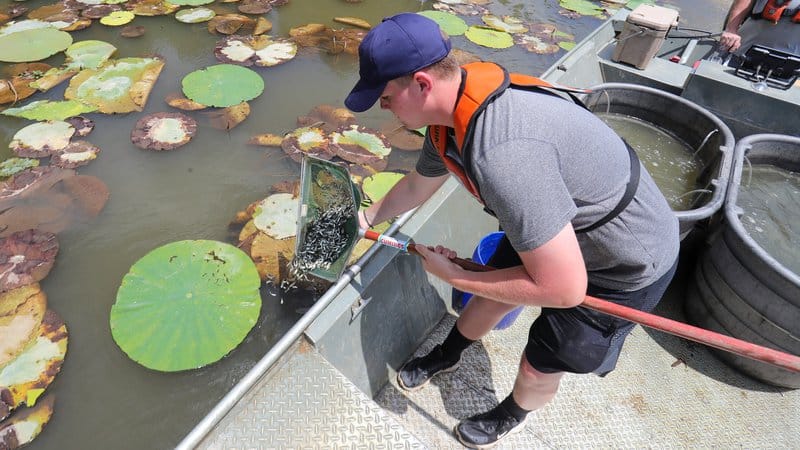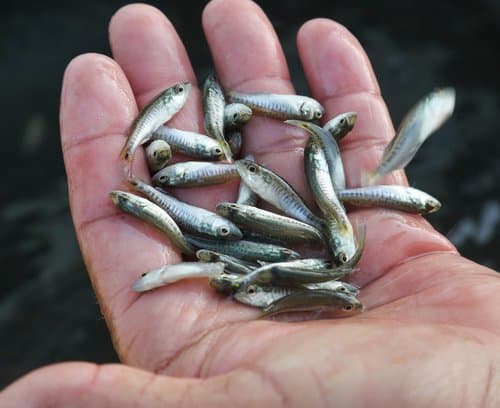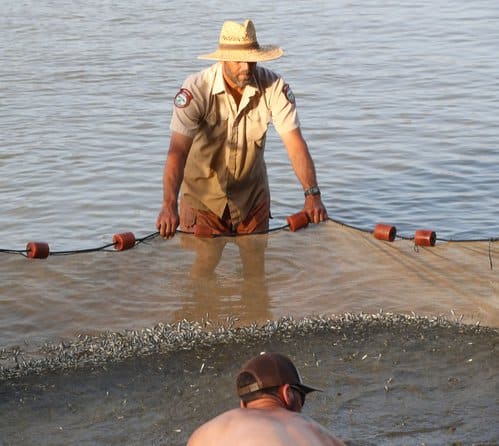Millwood one of many Arkansas lakes seeing Florida bass boost
ON 06-22-2022

June 22, 2022
Randy Zellers
Assistant Chief of Communications
SARATOGA — Arkansas Game and Fish Commission hatchery trucks delivered a quarter of a million Florida bass to the rich waters of Millwood Lake in southwest Arkansas last week as part of the AGFC’s continued effort to elevate the trophy potential of fish for Natural State bass anglers.
The fish were raised at Andrew Hulsey State Fish Hatchery in Hot Springs, and were hauled by truck to the waters of the fifth-largest reservoir in the state. This is only the first batch of fish headed to Millwood, with a total request of 400,000 fingerlings to be shipped this year, adding to the 1.8 million Florida bass fingerlings stocked here in the last decade.
After months of time invested in caring for broodstock, pairing them up in hatchery ponds, harvesting and hatching eggs and nourishing the fingerlings every step of the way, AGFC staff are careful to make sure their work has the best chance of success. Instead of simply backing down a boat ramp and opening a valve on the truck, AGFC staff hand-load nets full of fingerlings to waiting boats that will distribute them directly into cover.
“Boat ramps might be fine for catchable-size catfish and trout, but fingerlings benefit from the extra step of placing them directly into good cover where they can hide from predators and find food,” Tommy Laird, assistant chief of fisheries for the AGFC, said. “We have a lot invested in these fish, so boat stocking is preferred wherever we can do it.”
Millwood is one of many lakes being stocked this year with Florida largemouth bass. Others include Bear Creek Lake, Cane Creek Lake, Lake Chicot, Lake Conway, Lake Atkins, DeGray Lake, Lake Erling, Lake Columbia, Bragg Lake, Upper and Lower White Oak lakes, Wallace Lake, Barnett Lake, Lake Jack Lee in Felsenthal National Wildlife Refuge and Pool 2 of the Arkansas River. A handful of smaller lakes also have been chosen for these fish that are known for their ability to reach larger sizes than northern largemouth bass.
“We have requests to produce a total of more than 2.1 million Florida bass fingerlings this year,” Laird said. “We’ve definitely stepped up production of these fish in the last few years to improve fishing conditions in Arkansas lakes.”
Improving fish quality is the focus, according to Jason Olive, AGFC’s chief of fisheries.
“It surprises some anglers when we say that our goal when we stock Florida bass isn’t to increase the number of fish in the lake,” Olive said. “Instead, it’s about changing the genetics of the fish in the lake,” Olive said. “If you have the same amount of groceries, you’re going to end up with the same amount of fish. Every Florida bass we stock that survives isn’t adding to the population, but replacing a fish that would have been there through natural reproduction. We’re trying to choose Florida bass for their faster growth rate to capitalize on the conditions in the lake and hopefully create a better fishing experience for anglers.”
Requests for Florida bass may come from many districts, but lakes must meet certain criteria before Florida bass can be stocked with any measure of success.
“We have a limited supply of fingerlings our hatcheries can produce each year, so we have to hedge our bets where we know the stocking has the best chance of improving the genetics of the fishery,” Olive said.
Traditionally, shallower lakes in the southern half of the state with good fertility and vegetation have received the lion’s share of the Florida bass fingerlings the hatcheries produce. Longer growing seasons, more fertile water and excellent habitat allow a better opportunity for the fish to reach their potential. Angler desires also play a big part in the decision to stock Florida bass. These fish may grow larger, but they tend to be a bit more finicky, which may not appeal to the majority of anglers who use a particular body of water.
“When we conduct creel surveys and other angler outreach efforts, we still have anglers in some parts of the state who prefer to catch higher numbers of fish as opposed to fewer but larger fish,” Olive said. “We try to consider all anglers using the body of water as we move forward with any stockings or management.”
Olive says lakes that have seen recent renovations that enabled biologists to start with a “clean slate” also are prime candidates for Florida bass stockings.
“Lower White Oak Lake is a great example of a location where biologists were able to boost Florida bass genetics when the lake was renovated,” Olive said. “That, combined with the boom in aquatic habitat from the renovation, has created some massive fish with five-fish limits topping 22 pounds becoming more regular every week.”
Visit https://fb.watch/dPdTvY_yuc/ for more information on the AGFC’s Black Bass Management Program and Florida Bass stocking efforts.
Recent News
Subscribe to Our Weekly Newsletter E-mails
Don’t miss another issue. Sign up now to receive the AGFC Wildlife Weekly Newsletter in your mailbox every Wednesday afternoon (Waterfowl Reports are published weekly during waterfowl season and periodically outside the season). Fishing Reports arrive on Thursdays. Fill in the following fields and hit submit. Thanks, and welcome!


